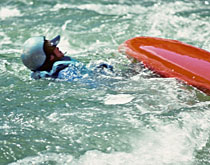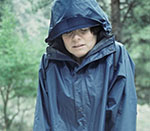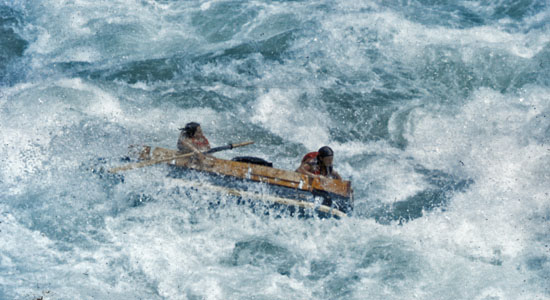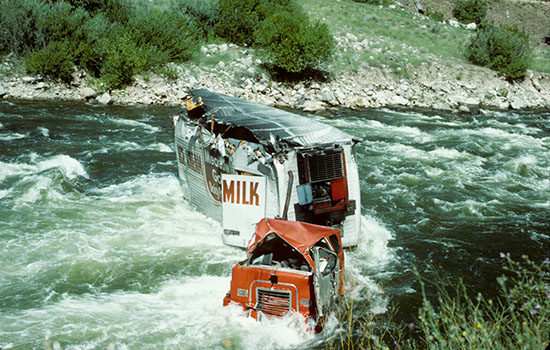Copyright & Revisions: Original copyright © 1996. Reformatted in 2013. No changes made to text.
Publication History: Originally published in the Proceedings of 1995 International Conference on Outdoor Recreation and Education. Citation: Watters, R. (1996). Whitewater river accident analysis. In Koesler, R & Watters, R. (Eds.), Proceedings of 1995 International Conference on Outdoor Recreation and Education. (pp. 159-167). Pocatello, ID: Idaho State University Press.
Reproduction Information: You are welcome to provide links to this page or to use short quotations and paraphrases in other documents as long as they appropriately reference the source. There is no charge for non-profit organizations to reproduce or publish extensive parts or all of this paper, but please obtain advanced permission from Ron Watters (wattron@isu.edu). Photo credits: Ron Watters.
Abstract
BASIS OF SAFE TRIPSOver the past few years, there has been a movement in the field of outdoor education to develop lists of commonly accepted outdoor activity safety practices. The Association of Experiential Education has been in the forefront of this effort, publishing a volume of common practices in different outdoor activity areas, including river running. If you are in charge of a river trip program, such material can serve as a good starting point from which to develop a safe water-based program, but it should only be a one part of your overall safety strategy.
No matter how it is viewed, the key to running safe river trips is good people. All else is secondary. If you have trip leaders and volunteers who have on-the-water training and experience, and who have developed good decision making skills, then you have most important basis of a safety program. There's no substitute for logging river miles, and trip leaders need to be the kind of people who enjoy going out on their free time and running rivers on a regular basis. It is only through actual river experience that people really learn about rivers, their moods and hazards, the complexities of working with groups and the intricacies of making decisions.
DECISION MAKING FACTORSDecision making on river trips is never easy. A great variety of factors enter into nearly any decision made on the water. To understand the decision making process, it is helpful to identify contributory factors and understand their relationship to one another. Some initial work in this area has been by Alan Hale and Rick Curtis (1995) of Princeton University Outdoor Action Program. They have proposed the "Dynamics of Accidents Model" in which the potential for accidents is dependent upon two general hazards: Environmental Hazards and Human Factor Hazards. Hale and Curtis hypothesize that the overall potential for accidents increases by the number of environmental factors times the number of human factors:
Accident Potential = Environmental Hazards x Human Hazards
In a paper authored by Curtis and available on the Princeton Outdoor Action website, he gives some examples of environmental hazards: adverse weather, remote location, undercut rocks, strainers, holes, cold temperatures; and examples of human factors: fear, low skill level, resistance to instructions, careless attitude, little or no awareness of hazards, exhaustion, etc. The lists go on and on.
Hale and Curtis point out that the formula is useful in enlisting the help of all members of the party: "It is essential to teach the Dynamics of Accidents Formula at the very beginning of trips so that all participants are aware of how their behavior is directly related to reducing the possibility of accidents. Participants can then take some responsibility of their safety." Having participants on river trips fully involved with minimizing hazards is a powerful ingredient in making safe river trips. Trips are safer by far when all members of the party are watching out for one another.
RIVER ACCIDENT CASE STUDIESThe most important aspect of preventing accidents occurs at the decision making stage when less experienced boaters depend on those with more experience. How do we prepare our volunteers and trip leaders to make good decisions? Experience, of course, is the best teacher, but there is also another valuable learning tool that can be used in concert with river experience: the study of river accidents.
The use of river accident case studies as a teaching aid is sobering, eye opening and enlightening. Case studies vividly describe what can go wrong when basic river safety procedures are violated. We all need an occasional visit to the other, frightful side of outdoor programming. Often when trips are running smoothly year after year, we and our staffs can be lolled into a false sense of security, and an occasional review of someone else's misfortune can shake us to our senses again.
Case studies also show that making decisions isn't always cut and dry. Each year there are river accidents in which no basic safety procedure has been violated. From such accidents, we are reminded that rules or lists of common safety practices can't always be relied upon, and that we must and have to do our own thinking.
Of all the people who have been involved in compiling information on river accidents one person stands out. His name is Charles Walbridge, and for nearly twenty years he has been the driving force behind the collection and dissemination of information and data on river accidents. Walbridge who owns Wildwater Designs, a whitewater boating supply company, has headed the Safety Task Force under the American Canoe Association and serves as the American Whitewater Affiliation's Safety Chairman.
Walbridge has edited or co-edited several publications which are, without exception, the best sources of whitewater accident information. Those include:
All three of the reports were published by the American Canoe Association.
Other information on accidents can be found on an occasional basis in the American Whitewater Affiliation Journal. Recently, it has also published yearly summaries of river accidents and fatalities. Whitewater publications oriented to large consumer markets, such as Paddler and Canoe & Kayak, rarely run case study articles and are less useful as source of accident information.
The sport of river running is not the only part of the outdoor recreation world that has made some type of systematic attempt to compile accident information, nor is it the first. The venerable American Alpine Club has been compiling rock climbing and mountaineering accident data for many years in its yearly publication Accidents in North American Mountaineering. Avalanche researchers have also assembling information on avalanche accidents in a series of publications known as Snowy Torrents.
A SAMPLE CASE STUDYCase studies vary in usefulness. Those accounts in which the accident is carefully detailed by actual eye witnesses are the best. The following is an example of one such case study from River Safety Task Force Newsletter (Walbridge, 1983). Since this was a club excursion, it was structured similar to many trips which are run by non-profit programs and has value as for leaders and program directors:The annual Feather River Boat-in for 1986 was the scene of a drowning on April 20th. Highway construction due to flooding kept all but a group from the Sierra Nevada Whitewater Club from attending. On Sunday, April 20th, Al McManus lost his life while on the Sloat to Nelson Point section of the Middle Fork of the Feather River. This Class II section was running approximately 700 cfs. The day was warm and the water temperature in the mid-50s. Al seemed to be picking up the basics again in moving water, as he had not kayaked since the fall. Although he appeared to be doing quite well, he had expressed a certain apprehension about the river to another in the group. About one and one-half miles into the trip, near the Carmack Mine area, we came to a rapid that was more challenging than the rest. I pulled the group into a large eddy that was situated above and to side of the rapid. The rapid could be clearly viewed from the eddy. The group was offered the option to walk the rapid. I warned the group that anyone running the rapid must take the river left chute to avoid a large rock in the center onto which most the flow was going. The right side was blocked by a series of rocks that an expert could maneuver through but that novice or intermediate might have trouble with. The first four boaters ran the left slot. Two boaters portaged. Matt, a beginner, was next. He shot out into the center. As Matt struggled to maneuver to the left, he hit a rock and swam. Gary and I rescued him at the bottom of the rapid. As we finished the rescue, I looked upstream to see Al enter the rapid. He shot into the center and floated sideways downstream. He made no attempt to avoid the rock. As he hit the rock sideways, he rolled upstream and disappeared from sight. I grabbed two through ropes and at least six carabiners. Matt and I ran up the shore but could see no sign of the boat. Two locals who had been watching us run the rapids were sent for an ambulance and the Sheriff. We threw my throw rope across the top of the rock. I used the rope to get near the rock and then swam into the eddy below it. The rock was very slippery and several attempts were made before I managed to a clip a carabiner to the submerged boat's grab loop. It took all eight paddlers to eventually pull the boat free. CPR was begun immediately. A line was set up across the river. I turned two kayaks and two paddles into a raft. We placed Al on the makeshift and continued CPR while we ferried him over to the other shore . The ambulance arrived within 40 minutes of the accident. At a Quincy hospital Al was pronounced dead. ANALYSIS: I learned several things form this accident. Although the rescue took 7 to 10 minutes, you really only have three minutes to rescue anybody trapped underwater. The kayak, a Taurus, was not a fault, as Al was trapped against the bottom with the kayak on top of him. The boat did not bend. In the future, beginners will not be given the option of whether to portage or run certain rapids on my trips. At the International Conference on Outdoor Recreation and Education at Cornell University where this paper was presented, the group attending this session entered into a discussion about the Feather River accident. Dennis Johnson from the University of California at Davis said that it is important that trip leaders know the river well. Making prudent decisions on river trips take in account a good working knowledge of the river and its rapids at various water levels. Johnson also pointed out that although, it is uncertain from the accident description, some locations on rivers harbor particularly insidious boulders and undercut rocks that have a history of entrapment. A river party needs to be aware of such areas and use extra caution at such locations.
Lately there has been a very welcome attempt to inform boaters of the locations of dangerous rocks. After two kayaker fatalities on Initiation Rapid on the Upper Gauley River, an informal coalition of boaters and river organizations published a "Safety Bulletin" and posted it in a variety of access points near the river (Tanger, 1995). This is a valuable service to paddlers, and boating organizations, land management agencies and non-profit groups can do much to help make rivers safer by making such information widely available.
In further discussion concerning the Feather River fatality, Mike Beiser from the University of Idaho commented that in any potentially dangerous situation, the leader must make sure that the group has been given clear instructions prior to running the rapid. In this case, the sequence of events which led to the death might have been interrupted had members of the group been instructed to wait should any boater come out of their boat and need to be rescued. On the Feather River, the leader had just finished rescuing the first swimmer when the victim started into the rapid. If the leader had a chance to get back up the river prior to the victim's run, he might have been able to talk to the victim and give him another chance of portaging.
Beiser also talked about the importance of the sweep boater. Experienced sweep boaters can help by shouting out directions from their position in the rear or move into a key eddy where they can point out the safe route to beginning boaters.
Throughout the discussion, members of the Cornell group reminded one another that this was a class II river. Very rarely do paddling groups set up elaborate safety systems at Class II rapids. In this case, the trip leader was careful, allowed members of the group the option to portage and otherwise took normal river running precautions. Moreover, it always easy for armchair river runners to make suggestions after the fact.
The process, however, of sitting down and talking through accidents is a valuable learning device. Discussions about river fatalities can be easily be incorporated into staff training sessions. In their review of accidents, trip initiators and trip leaders have the opportunity to analytically dissect actual situations and mentally prepared themselves for how they would react in an emergency. In any study of accidents, one thing is apparent: one small decision can have far reaching consequences and a snowballing impact on the course of events that follow. Trip leaders and members of river groups must never lose sight of the importance of small decisions. When weighing options on a river, the option which is the most conservative should always be given due consideration. One can not let down their guard, even in something as mundane as a class II rapids.
A REVIEW OF 1995 ACCIDENTSThe adage that history repeats itself applies as much to accidents as it does to history. That accidents do repeat themselves is obvious by looking at a summary of accidents from the 1995 whitewater season. The information was summarized from an article in the September-October issue of American Whitewater (Walbridge, 1995).
1/95 West Branch of Cazenonia Creek NY
3/95 Lehigh River PA
3/95 San Juaquin CA
4/95 Russell Fork Gorge VA
4/95 Chattooga GA
5/95 Six Mile AK
5/95 Duckabush WA
5/95 North Fork of the Flathead MT
5/95 Whitewater River IN
5/95 Merced River CA
6/95 North Fork American CA
7/95 North Fork Yuba CA
6/95 Gallatin MT
6/95 Colorado near Rifle CO
6/95 Hoback River WY
6/95 Snake River, Milner Stretch ID
6/95 Snake, Alpine Stretch ID
6/95 Arkansas CO
7/95 Arkansas, Brown's Canyon CO
6/95 Ocoee TN
7/95 Nooksack WA
7/95 Cossatot AR A number of similarities can be found among the accidents, but one common theme in 1995 is related to ropes. Loose ropes are killers and boaters must take extra care to make sure that all lines are safely tied or tucked into bags. The 1995 year also continues a trend in whitewater world in which commercial fatalities are on the rise. Walbridge attributes this to more commercial companies running more difficult water: "For years the physical ability, experience, and fitness of rafting guests have been declining. Better equipment and improved guiding skills make it possible to run more difficult rivers, but the guest who ends up in the water may overwhelmed and helpless."
Walbridge's observation has implications beyond the commercial world. We are experiencing the same trends in the non-commercial area. Clubs, school and city programs are all running harder whitewater than they have in the past. In light of this trend, we need to make sure that participants in programs are prepared properly for the level of whitewater undertaken.
There is much more, of course, that needs to be done with river accident data. Researchers have the wonderful opportunity to do some ground breaking work. But from a teaching standpoint, case study information that is presently available is a tremendous resource from which outdoor educators can learn from and apply to water-based programs. As you begin to make plans for your river training programs, be sure to include the study and review of case studies. Your staff will be better informed and prepared, and your program will be safer as a result. REFERENCESHale, A., & Curtis, R. (1995). Princeton university outdoor action program: planning a safe river trip. (Available on the Princeton University Outdoor Action Web Page: https://www.princeton.edu/~oa/paddle/rivplan.shtml). Tanger, B. (July/August, 1995). Safety: Danger ahead. American Whitewater, p. 25. Walbridge, C. (Ed.). (1983). The best of the river safety task force newsletter. Lorton, VA: American Canoe Association. Walbridge, C. (Ed.). (1986). American canoe association: River safety report 1982-1985. Lorton, VA: American Canoe Association. Walbridge, C. (Ed.). (1989). American canoe association: River safety report 1986-1988. Newington, VA: American Canoe Association. Walbridge, Charles (1995, September/October). River accident overview 1995. American Whitewater, pp. 29-37. [END]
|




